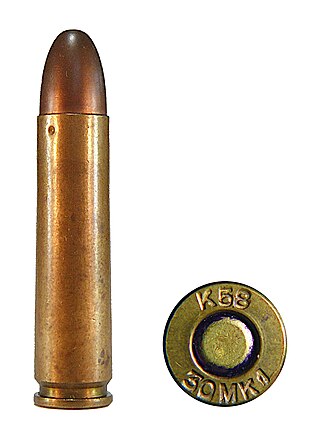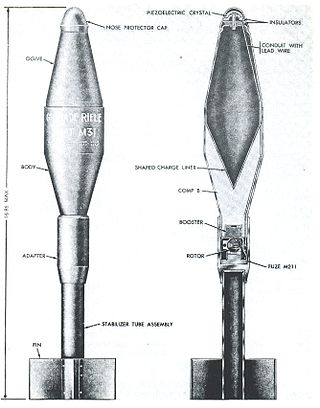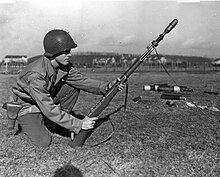
A semi-automatic rifle is an autoloading rifle that fires a single cartridge with each pull of the trigger, and uses part of the fired cartridge's energy to eject the case and load another cartridge into the chamber. In contrast, a bolt-action rifle requires the user to cycle the bolt manually before they can fire a second time, and a fully automatic rifle fires continuously until the trigger is released.

The M1 Garand or M1 rifle is a semi-automatic rifle that was the service rifle of the U.S. Army during World War II and the Korean War.

A recoilless rifle (rifled), recoilless launcher (smoothbore), or simply recoilless gun, sometimes abbreviated to "RR" or "RCL" is a type of lightweight artillery system or man-portable launcher that is designed to eject some form of countermass such as propellant gas from the rear of the weapon at the moment of firing, creating forward thrust that counteracts most of the weapon's recoil. This allows for the elimination of much of the heavy and bulky recoil-counteracting equipment of a conventional cannon as well as a thinner-walled barrel, and thus the launch of a relatively large projectile from a platform that would not be capable of handling the weight or recoil of a conventional gun of the same size. Technically, only devices that use spin-stabilized projectiles fired from a rifled barrel are recoilless rifles, while smoothbore variants are recoilless guns. This distinction is often lost, and both are often called recoilless rifles.
A semi-automatic firearm, also called a self-loading or autoloading firearm, is a repeating firearm whose action mechanism automatically loads a following round of cartridge into the chamber (self-loading) and prepares it for subsequent firing, but requires the shooter to manually actuate the trigger in order to discharge each shot. Typically, this involves the weapon's action utilizing the excess energy released during the preceding shot to unlock and move the bolt, extracting and ejecting the spent cartridge case from the chamber, re-cocking the firing mechanism, and loading a new cartridge into the firing chamber, all without input from the user. To fire again, however, the user must actively release the trigger, allow it to "reset", before pulling the trigger again to fire off the next round. As a result, each trigger pull only discharges a single round from a semi-automatic weapon, as opposed to a fully automatic weapon, which will shoot continuously as long as the ammunition is replete and the trigger is kept depressed.
A rifle grenade is a grenade that uses a rifle-based launcher to permit a longer effective range than would be possible if the grenade were thrown by hand.
The .30-06 Springfield cartridge, 7.62×63mm in metric notation, and called the .30 Gov't '06 by Winchester, was introduced to the United States Army in 1906 and later standardized; it remained in military use until the late 1970s. The ".30" refers to the caliber of the bullet in inches, .300 and the "06" refers to the year the cartridge was adopted, 1906. It replaced the .30-03, 6mm Lee Navy, and .30-40 Krag cartridges. The .30-06 remained the U.S. Army's primary rifle and machine gun cartridge for nearly 50 years before being replaced by the 7.62×51mm NATO and 5.56×45mm NATO, both of which remain in current U.S. and NATO service. It remains a very popular sporting round, with ammunition produced by all major manufacturers.

The .30 Carbine (7.62×33mm) is a rimless carbine/rifle cartridge used in the M1 carbine introduced in the 1940s. It is a light rifle round designed to be fired from the M1 carbine's 18-inch (458 mm) barrel.
Blowback is a system of operation for self-loading firearms that obtains energy from the motion of the cartridge case as it is pushed to the rear by expanding gas created by the ignition of the propellant charge.

Gas-operation is a system of operation used to provide energy to operate locked breech, autoloading firearms. In gas-operation, a portion of high-pressure gas from the cartridge being fired is used to power a mechanism to dispose of the spent case and insert a new cartridge into the chamber. Energy from the gas is harnessed through either a port in the barrel or a trap at the muzzle. This high-pressure gas impinges on a surface such as a piston head to provide motion for unlocking of the action, extraction of the spent case, ejection, cocking of the hammer or striker, chambering of a fresh cartridge, and locking of the action.
The Sturmgewehr 57 is a selective fire battle rifle designed by Schweizerische Industrie Gesellschaft of Switzerland. The Stgw. 57 assault rifle uses a roller-delayed blowback system similar to the blowback system of the Heckler & Koch G3 and CETME rifles. As an assault rifle, the model AM 55 entered service in the Swiss Army in three designations F. ass. 57 7.5mm and 7.5mm Stgw. 57. Technologically, the Stgw. 57 was the mechanical and design basis for the export-variations of the SG 510 family of small arms. After thirty-three years, from 1957 to 1990, the Swiss Army replaced the Stgw. 57 with the SIG SG 550, a lighter-weight assault rifle.

The Pedersen Rifle, officially known in final form as the T1E3 rifle, was a United States semi-automatic rifle designed by John Pedersen that was made in small numbers for testing by the United States Army during the 1920s as part of a program to standardize and adopt a replacement for the M1903 Springfield.

A 22 mm rifle grenade is inserted over the firing mechanism on the front of rifles that are equipped with the appropriate spigot-type launcher, either in the form of an integral flash suppressor or a detachable adapter. As with most rifle grenades, it is propelled by a blank cartridge inserted into the chamber of the rifle. A 22 mm (0.87 in) grenade can range from a powerful anti-tank round to a simple finned tube with a fragmentation hand grenade attached to the end. The "22 mm" refers to the diameter of the base tube which fits over the spigot of the launcher, not the diameter of the warhead section, which is much wider.
The Energa anti-tank rifle grenade is a rifle-launched anti-tank grenade that is propelled by a ballistite-filled blank cartridge. The name Energa comes from the firm in Liechtenstein that designed it, the Anstalt für die ENtwicklung von ERfindungen und Gewerblichen Anwendungen, based in Vaduz.
The high–low system is a design of cannon and anti-tank warfare launcher using a smaller high-pressure chamber to store propellant. It allows a much larger projectile to be launched without the heavy equipment usually needed for large caliber weapons. When the propellant is ignited, the higher pressure gases are bled out through vents at reduced pressure to a much larger low pressure chamber to push a projectile forward. The high-low system allows the weight of the weapon and its ammunition to be reduced significantly. Production cost and time are drastically lower than for standard cannon or other small-arm weapon systems firing a projectile of the same size and weight. It has a far more efficient use of the propellant, unlike earlier recoilless weapons, where most of the propellant is expended to the rear of the weapon to counter the recoil of the projectile being fired.

The M31 HEAT is a fin-stabilized anti-tank rifle grenade designed in the late 1950s to replace the Belgian ENERGA rifle grenade which was adopted by the US Army and US Marines as an emergency stop-gap measure during the Korean War. Like the ENERGA, it has a nose-initiated, based-detonated HEAT warhead, but unlike the ENERGA, the mechanical impact fuse system is replaced with a less complex and more reliable piezo-electric fuse system which also allows higher angles of impact, up to 65 degrees.

Man-portable anti-tank systems are traditionally portable shoulder-launched projectile systems firing heavy shell-type projectiles, typically designed to combat protected targets, such as armoured vehicles, field fortifications and at times even low-flying aircraft.

The M1 grenade projection adapter was an expedient rifle grenade used by the American military in World War II, Korea, and Vietnam. It consisted of an add-on 22 mm (0.87 in) stabilizer tube and fins that converted a hand-grenade into a rifle grenade. It supplanted the M17 rifle grenade, and was eventually made obsolete by the 40 mm M79 grenade launcher.
The Tromboncino M28 was an interwar period infantry weapon developed by the Italians. It combined a grenade launcher with a carbine.












